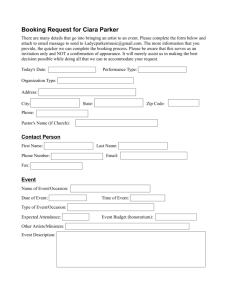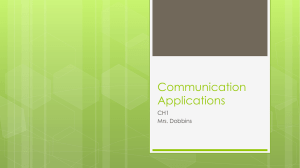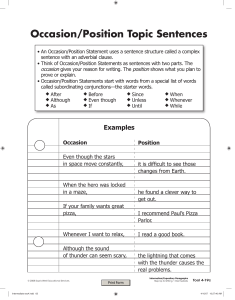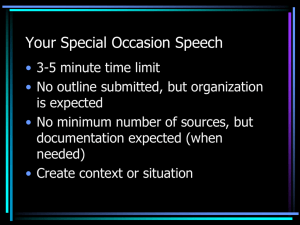History and Physical I
advertisement
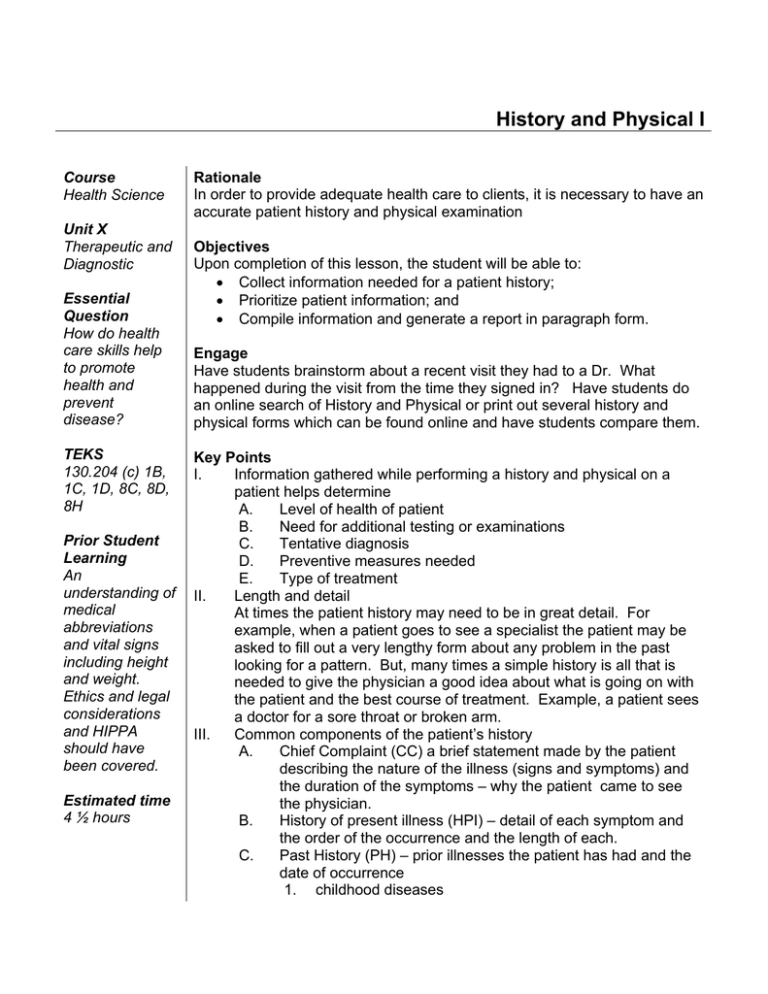
History and Physical I Course Health Science Unit X Therapeutic and Diagnostic Essential Question How do health care skills help to promote health and prevent disease? TEKS 130.204 (c) 1B, 1C, 1D, 8C, 8D, 8H Prior Student Learning An understanding of medical abbreviations and vital signs including height and weight. Ethics and legal considerations and HIPPA should have been covered. Estimated time 4 ½ hours Rationale In order to provide adequate health care to clients, it is necessary to have an accurate patient history and physical examination Objectives Upon completion of this lesson, the student will be able to: • Collect information needed for a patient history; • Prioritize patient information; and • Compile information and generate a report in paragraph form. Engage Have students brainstorm about a recent visit they had to a Dr. What happened during the visit from the time they signed in? Have students do an online search of History and Physical or print out several history and physical forms which can be found online and have students compare them. Key Points I. Information gathered while performing a history and physical on a patient helps determine A. Level of health of patient B. Need for additional testing or examinations C. Tentative diagnosis D. Preventive measures needed E. Type of treatment II. Length and detail At times the patient history may need to be in great detail. For example, when a patient goes to see a specialist the patient may be asked to fill out a very lengthy form about any problem in the past looking for a pattern. But, many times a simple history is all that is needed to give the physician a good idea about what is going on with the patient and the best course of treatment. Example, a patient sees a doctor for a sore throat or broken arm. III. Common components of the patient’s history A. Chief Complaint (CC) a brief statement made by the patient describing the nature of the illness (signs and symptoms) and the duration of the symptoms – why the patient came to see the physician. B. History of present illness (HPI) – detail of each symptom and the order of the occurrence and the length of each. C. Past History (PH) – prior illnesses the patient has had and the date of occurrence 1. childhood diseases 2. 3. 4. 5. 6. 7. D. E. F. operations hospital admissions serious injuries and disabilities shot record (immunizations) allergies (including drug reaction) for women only – number of pregnancy and number of live births as well as date of last menstrual cycle Family history (FH) – the family history is the summary of the health status and age of immediate relatives (parents, siblings, grand parents and in some cases children); if deceased, the date, age at death, and the cause are noted. Diseases among relatives that are thought to have hereditary tendency are also recorded. Examples are cancer, diabetes, heart problems, kidney problems, mental health conditions, infectious diseases, etc. Social and occupational history (SH) – information relating to the type of job, where the patient lives, recent travel, personal habits and lifestyle 1. use of tobacco, alcohol, drugs, coffee, etc. 2. diet, sleep, exercise, and hobbies 3. marital history, children, home life, occupation, religious convictions 4. resources and support Review of systems (ROS) – reveals subjective symptoms that either the patient forgot to discuss or at the time seemed relatively unimportant to the patient. Examples: a history of headaches any vision problems, hearing, etc. Activity I. Interview a classmate utilizing the Medical History Sheet. (Stress to the students the importance of keeping information obtained from classmate confidential. It is a good time to review ethics and legal implications and HIPPA. II. Interview a family member utilizing the Medical History Sheet. III. Summarize all information obtained in a written paragraph form. (Sample history write-up is included in this lesson.) Assessment Completion of Medical History Sheet Materials Medical History Sheet Teacher Note: An overhead of the Medical History Sheet would be very useful while talking about each section. This is a great time to have a review of basic skills for vital signs and measurement of height and weight. Accommodations for Learning Differences For reinforcement, the student will outline the components of a medical history sheet. For enrichment, the student will compare and contrast health histories of two or more patients with the same disease/disorder. National and State Education Standards National Health Science Cluster Standards HLC 10.01 Health Care Workers will apply technical skills required for all career specialties. They will demonstrate skills and knowledge as appropriate. TEKS 130.204 (c)(1)(B) communicate using medical terminology; 130.204 (c)(1)(C) express ideas in writing and develop skills in documentation; 130.204 (c)(1)(D) interpret complex technical material related to the health science industry. 130.204 (c)(8)(C) articulate comprehension of assignment; 130.204 (c)(8)(D) employ medical vocabulary specific to the health-care setting; and 130.204 (c)(8)(H) demonstrate first aid, vital signs, cardiopulmonary resuscitation, and automated external defibrillator skills in a laboratory setting. Texas College and Career Readiness Standards English/Language Arts I. A. Compose a variety of texts that demonstrate clear focus, the logical development of ideas in well organized paragraphs and the use of appropriate language that advances the author’s purpose. History and Physical Name Address Telephone Occupation BD Insurance Family History: Father Brothers Cancer Diabetes Heart Rheumatism Obesity Epilepsy Case No. Date SS SMWD Referred Mother Sisters Tuberculosis Gout Goiter Insanity Nephritis Other Past History: Diphtheria Chickenpox Typhoid Pneumonia Boils Operations Measles Mumps Scarlet Fever Smallpox Malaria Gonorrhea Syphilis Tonsillitis Jaundice Infections Nephritis Other Personal History: Menstrual: Onset Marital: Miscarriages Habits: Alcohol Tea/coffee Sleep Other: Periodicity Abortions Tobacco Meals BM Type Children Duration Drugs Water Exercise Chief Complaint: History of present illness: Ht. Wt. T. P. R BP Sample Medical History KC is a 17 y/o female student, a junior in high school, who lives at home with her mother and father and 2 siblings, 1 brother age 13 and a sister age10. KC is in for a routine physical examination. KC’s family history is positive for heart disease, father, and diabetes, grandmother and brother. There is no family history of any other disease. KC’s past history include she is up to date with her immunizations which include; Polio, Tetanus and Diptheria, Measles, Mumps and Rubella and Hepatitis B. She says that she gets Upper Respiratory Infections (URI) with tonsillitis about 3x/year. She denies having surgery. Her menstruation began at age 12; she has irregular menses and LMP was 3/10/08. Menstruation lasts approximately 5 days. She states that she has never been pregnant. When asked, she denies having smoked, drinks alcohol on occasion when she is out with friends and she says that she has never used illegal drugs. The only over the counter (OTC) drug which she uses regularly is Tylenol. She takes two tablets on occasion when she has a headache, which she says that she gets about 2x/ week. She drinks tea on occasion, she is not a coffee drinker and she does drink 1-2 cokes per day. Her mother fixes the meals at home and she eats 3 meals a day with an occasional snack after she gets out of school and sometimes before she goes to bed. She goes to bed at 2300 and gets up at 0630 each day. On occasion she has trouble sleeping which she feels is due to school stress. Elimination is 1x/day, usually at night and she says for exercise she runs approximately 1 mile 3x/week. T-98.2F P-88 R-16 BP- 112/64 Ht.- 5’2” Wt.- 120 lbs


